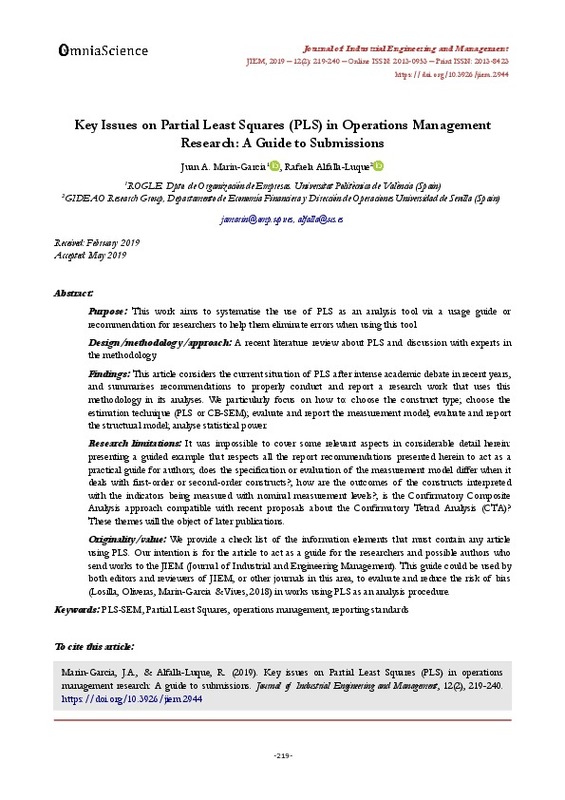JavaScript is disabled for your browser. Some features of this site may not work without it.
Buscar en RiuNet
Listar
Mi cuenta
Estadísticas
Ayuda RiuNet
Admin. UPV
Key Issues on Partial Least Squares (PLS) in Operations Management Research: A Guide to Submissions
Mostrar el registro sencillo del ítem
Ficheros en el ítem
| dc.contributor.author | Marin-Garcia, Juan A.
|
es_ES |
| dc.contributor.author | Alfalla-Luque, Rafaela
|
es_ES |
| dc.date.accessioned | 2021-01-12T21:02:11Z | |
| dc.date.available | 2021-01-12T21:02:11Z | |
| dc.date.issued | 2019 | es_ES |
| dc.identifier.issn | 2013-0953 | es_ES |
| dc.identifier.uri | http://hdl.handle.net/10251/158834 | |
| dc.description.abstract | [EN] Purpose: This work aims to systematise the use of PLS as an analysis tool via a usage guide or recommendation for researchers to help them eliminate errors when using this tool. Design/methodology/approach: A recent literature review about PLS and discussion with experts in the methodology. Findings: This article considers the current situation of PLS after intense academic debate in recent years, and summarises recommendations to properly conduct and report a research work that uses this methodology in its analyses. We particularly focus on how to: choose the construct type; choose the estimation technique (PLS or CB-SEM); evaluate and report the measurement model; evaluate and report the structural model; analyse statistical power. Research limitations: It was impossible to cover some relevant aspects in considerable detail herein: presenting a guided example that respects all the report recommendations presented herein to act as a practical guide for authors; does the specification or evaluation of the measurement model differ when it deals with first-order or second-order constructs?; how are the outcomes of the constructs interpreted with the indicators being measured with nominal measurement levels?; is the Confirmatory Composite Analysis approach compatible with recent proposals about the Confirmatory Tetrad Analysis (CTA)? These themes will the object of later publications. Originality/value: We provide a check list of the information elements that must contain any article using PLS. Our intention is for the article to act as a guide for the researchers and possible authors who send works to the JIEM (Journal of Industrial and Engineering Management). This guide could be used by both editors and reviewers of JIEM, or other journals in this area, to evaluate and reduce the risk of bias (Losilla, Oliveras, Marin-Garcia & Vives, 2018) in works using PLS as an analysis procedure. | es_ES |
| dc.language | Inglés | es_ES |
| dc.publisher | Omnia Publisher SL | es_ES |
| dc.relation.ispartof | Journal of Industrial Engineering and Management | es_ES |
| dc.rights | Reconocimiento - No comercial (by-nc) | es_ES |
| dc.subject | PLS-SEM | es_ES |
| dc.subject | Partial Least Squares | es_ES |
| dc.subject | Operations management | es_ES |
| dc.subject | Reporting standards | es_ES |
| dc.subject.classification | ORGANIZACION DE EMPRESAS | es_ES |
| dc.title | Key Issues on Partial Least Squares (PLS) in Operations Management Research: A Guide to Submissions | es_ES |
| dc.type | Artículo | es_ES |
| dc.identifier.doi | 10.3926/jiem.2944 | es_ES |
| dc.rights.accessRights | Abierto | es_ES |
| dc.contributor.affiliation | Universitat Politècnica de València. Departamento de Organización de Empresas - Departament d'Organització d'Empreses | es_ES |
| dc.description.bibliographicCitation | Marin-Garcia, JA.; Alfalla-Luque, R. (2019). Key Issues on Partial Least Squares (PLS) in Operations Management Research: A Guide to Submissions. Journal of Industrial Engineering and Management. 12(2):219-240. https://doi.org/10.3926/jiem.2944 | es_ES |
| dc.description.accrualMethod | S | es_ES |
| dc.relation.publisherversion | https://doi.org/10.3926/jiem.2944 | es_ES |
| dc.description.upvformatpinicio | 219 | es_ES |
| dc.description.upvformatpfin | 240 | es_ES |
| dc.type.version | info:eu-repo/semantics/publishedVersion | es_ES |
| dc.description.volume | 12 | es_ES |
| dc.description.issue | 2 | es_ES |
| dc.relation.pasarela | S\401180 | es_ES |








